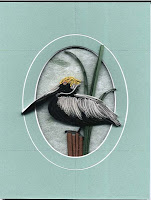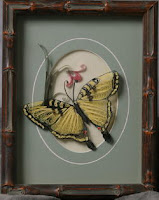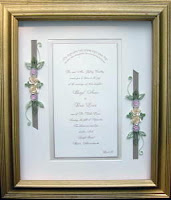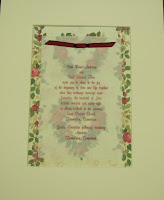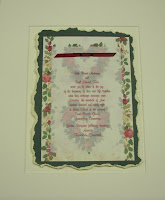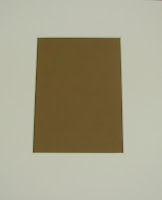Specialty Quilling Papers-Graduated and Dark Centers
We get a lot of questions about the specialty papers we carry, so I thought that might be a good topic to cover here. One of the questions we get frequently is "What are they used for?" Let me get some of the basic information about the strips first, and then we'll give some suggestions as to how they can be used. When we first brought graduated and dark center strips in from England, there was nothing like them here in the USA. All of the English graduated and dark center strips are 12" long. That's because they are printed on the paper. The English graduated strips come in 10 colors and in all 4 widths: 1/16", 1/8", ¼" and 3/8"as well as mixed/multi packs. One end of the strip is very pale, (almost white) and the color gets deeper as it goes up the strip. The dark center strips are pale on both ends with the deeper color being in the middle of the strip. The English strips come in pink, orange, yellow, opal green (which is like a turquoise), bright green, blue, red, lilac, brown and black. They are available in single packages or mixed/multi packages with all ten colors. Lake City now has some papers which they call watercolors which are dark center. They are also 12" long, and come in mixed packs only, no single color packs, in 1/8", `/4", and 3/8" widths. They come in ten colors which are quite close to the English colors except they have two shades of pink and no opal green. Paplin Products have also created a line of graduated (although they are actually dark center strips) papers. They are available in all 4 widths , their colors include red, yellow, fern green, peach, purple, orange olive green, pink, federal blue, orchid, and hyacinth (which is like a pale periwinkle) I like the Paplin colors because they "match" their regular papers. For example; the English and Lake City greens are bright almost Christmas green and that's a color I only use for Christmas. Paplins olive green and fern green are the kind of greens I prefer in my work. Quilled Creations also have graduated and dark center strips in the same colors as the English strip, but don't offer them in 1/16".
We get a lot of questions about the specialty papers we carry, so I thought that might be a good topic to cover here. One of the questions we get frequently is "What are they used for?" Let me get some of the basic information about the strips first, and then we'll give some suggestions as to how they can be used. When we first brought graduated and dark center strips in from England, there was nothing like them here in the USA. All of the English graduated and dark center strips are 12" long. That's because they are printed on the paper. The English graduated strips come in 10 colors and in all 4 widths: 1/16", 1/8", ¼" and 3/8"as well as mixed/multi packs. One end of the strip is very pale, (almost white) and the color gets deeper as it goes up the strip. The dark center strips are pale on both ends with the deeper color being in the middle of the strip. The English strips come in pink, orange, yellow, opal green (which is like a turquoise), bright green, blue, red, lilac, brown and black. They are available in single packages or mixed/multi packages with all ten colors. Lake City now has some papers which they call watercolors which are dark center. They are also 12" long, and come in mixed packs only, no single color packs, in 1/8", `/4", and 3/8" widths. They come in ten colors which are quite close to the English colors except they have two shades of pink and no opal green. Paplin Products have also created a line of graduated (although they are actually dark center strips) papers. They are available in all 4 widths , their colors include red, yellow, fern green, peach, purple, orange olive green, pink, federal blue, orchid, and hyacinth (which is like a pale periwinkle) I like the Paplin colors because they "match" their regular papers. For example; the English and Lake City greens are bright almost Christmas green and that's a color I only use for Christmas. Paplins olive green and fern green are the kind of greens I prefer in my work. Quilled Creations also have graduated and dark center strips in the same colors as the English strip, but don't offer them in 1/16".
OK, so what do you do with them? I guess the first thing to think about is how long a strip you usually use. I generally don't use anything longer than 6" for conventional quilled shapes, so for me the dark centers work well; I cut the strips in half and then I have two six inch graduated strips. Then you decide whether you want the lighter or darker color on the inside of your shape, and that's where you start rolling. I especially like to used the graduated strips when I am doing wheatears or alternate side looping, (you remember, that's husking without pins). The quilling in those techniques is much more open so you really get to appreciate the shading differences in the papers. I will use the whole 12" strip for husked petals and love the effect of the petal center one shade and the shade deepens as you finish the petal, with the darker shade wrapping the petal. I also like fringed flowers using the graduated and dark center papers, it is a somewhat softer look than using two totally different colors. There is also a flower that I like to make that reminds me of lupines. It is a series of open s scrolls that get progressively smaller and the shade changes very softly with these papers. I don't remember where I first saw it, probably in one of Jane Jenkins books. On page 36 of her book Quilling Techniques and Inspiration, she has a very pretty arrangement of flowers all made with graduated and dark center papers. Next up we'll talk about two toned papers, and I will get some pictures posted so you can get the effect of these and other specialty papers. I would also like to see what you are doing with these strips. Stay tuned.


